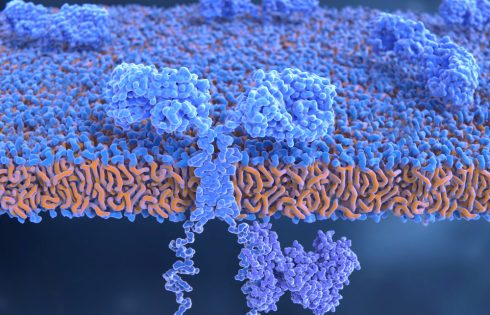
In a new study published in GEN’s sister peer-review journal, GEN Biotechnology, titled, “Exploring Structure-Function Relationships in Engineered Receptor Performance Using Computational Structure Prediction,” researchers from Northwestern University present a new structure-based analysis to guide the design of synthetic receptors for improved cell therapies.
“A key challenge is that subtle structural changes can have profound functional consequences, and thus cell therapies can benefit from improved methods for tuning receptor functions at the structural level,” said Joshua Leonard, PhD, professor of chemical and biological engineering at Northwestern University and corresponding author of the study, in an interview with GEN.
In cell therapies, engineered receptors need to encompass both safety and efficacy, such as maintaining a resting state until it encounters a disease target. However, the structure of these receptors is generally poorly understood, which can have a substantial impact on therapeutic performance. In the example of CAR T-cell therapies, structurally tuning receptors can avoid tonic signaling, or activation in the absence of the target stimulus, which often drives T-cell exhaustion and diminishes the therapy’s efficacy against targets, such as a tumor.
The authors generated receptor structural models to investigate the structure-function relationships using a case study that characterized the conversion of natural human cytokine receptors into engineered receptors. They hypothesized that structure prediction might be most feasible on a dataset based on natural receptors, given the reliance of existing tools on sequence alignment with known proteins.
The authors also extended the analysis to “categorical” variables that describe the identity of specific domain choices and the way in which they are combined, which implicitly captures properties that are unique to the individual chains and not described by structural features directly, such as protein expression, membrane localization, protein stability. Overall, they observed structure-function trends that were largely conserved across structurally diverse receptor sets.
Engineered receptors are a particularly challenging class of proteins to structurally define, as they are relatively large, contain a difficult-to-characterize hydrophobic transmembrane domain, and can adopt multiple conformations. Groundbreaking tools, such as AlphaFold, which solved biology’s hallmark problem of determining a protein’s 3D structure from its sequence and earned DeepMind’s Demis Hassabis, PhD, and John Jumper, PhD, a share of the 2024 Noble Prize in Chemistry, AlphaFold Multimer, and RoseTTAFold (developed by fellow 2024 Nobel Laureate, David Baker, PhD), have been able to construct complete models of natural single-pass transmembrane receptors. However, distilling which structural features impact receptor performance remains an ongoing gap.
“For all the aspects of the receptor we don’t understand, we have to spend more time and effort empirically exploring design choices, and even when good designs are identified, this lack of structural knowledge makes it more difficult to understand why certain choices yield good performance,” said Leonard.
The GEN Biotechnology study proposes potential design rules that are experimentally testable and can guide future engineering across receptor families. Leonard and William Corcoran, lead author of the study and a PhD candidate at Northwestern, expect that these insights will most immediately benefit the design of synthetic receptors that share a similar signaling mechanism, given that the study was based on the conversion of natural receptors (which employ multiple mechanisms) into synthetic receptors (which employ a single mechanism).
Looking ahead, the authors stated that a natural evolution of this workflow is to generate libraries that explore greater design space. In addition, Leonard’s group has several ongoing projects for developing and employing distinct synthetic receptor families and plans to apply the insights from this study to design new synthetic receptors for more applications.
“Ultimately, this study makes us optimistic that protein structure prediction tools, while ever improving, are already useful for making plausible connections between receptor sequence and receptor function, and that fact should accelerate the development of

